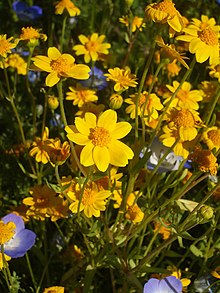Lasthenia
| Goldfields | |
|---|---|
 |
|
|
Yellow-ray Goldfields Lasthenia glabrata |
|
| Scientific classification | |
| Kingdom: | Plantae |
| (unranked): | Angiosperms |
| (unranked): | Eudicots |
| (unranked): | Asterids |
| Order: | Asterales |
| Family: | Asteraceae |
| Subfamily: | Asteroideae |
| Tribe: | Heliantheae |
| Genus: |
Lasthenia Cass. |
| Type species | |
|
Lasthenia californica DC. ex Lindl. |
|
| Species | |
|
18 |
|
18
Lasthenia, commonly known as goldfields, is a genus of the botanical family Asteraceae. The genus is named after Lasthenia, a cross-dressing female pupil of the ancient Greek philosopher Plato.
The goldfield genus comprises annual, rarely perennial herbs that are as either glabrous or hairy. Stems are typically branched and erect, attaining a height of less than 60 centimeters. Their opposite leaves, of length of up to 20 centimeters are entire to pinnate.
Inflorescences are characterized by solitary heads (sometimes in cymes), with phyllaries free or partly fused. The receptacle may present as naked and narrowly conic to hemispheric. The normally yellow ray flowers may number four to 16, and the ligules are typically yellow as well. The disk flowers are numerous and generally yellow corollae are typically five-lobed; anther tips manifest as acuminate to triangular, while style tips may be triangular or round, but typically hair-tufted.
Fruits are less than five millimeters across, cylindric to obovoid in shape, and black or gray in color. The pappus may present awns or scales, or infrequently neither. The genus is mostly cross-pollinated, with some insects serving as pollinators.
Goldfield species occur over a range of habitat, such as meadows, shrubland and open forest, but tend towards semiarid conditions. They are commonly found at ephemeral pools and are important plants in coastal regions. They are visited by Sciaridae fungus gnats for nectar, and it is possible that these animals are key pollinators at least for Contra Costa Goldfields (L. conjugens).
...
Wikipedia
